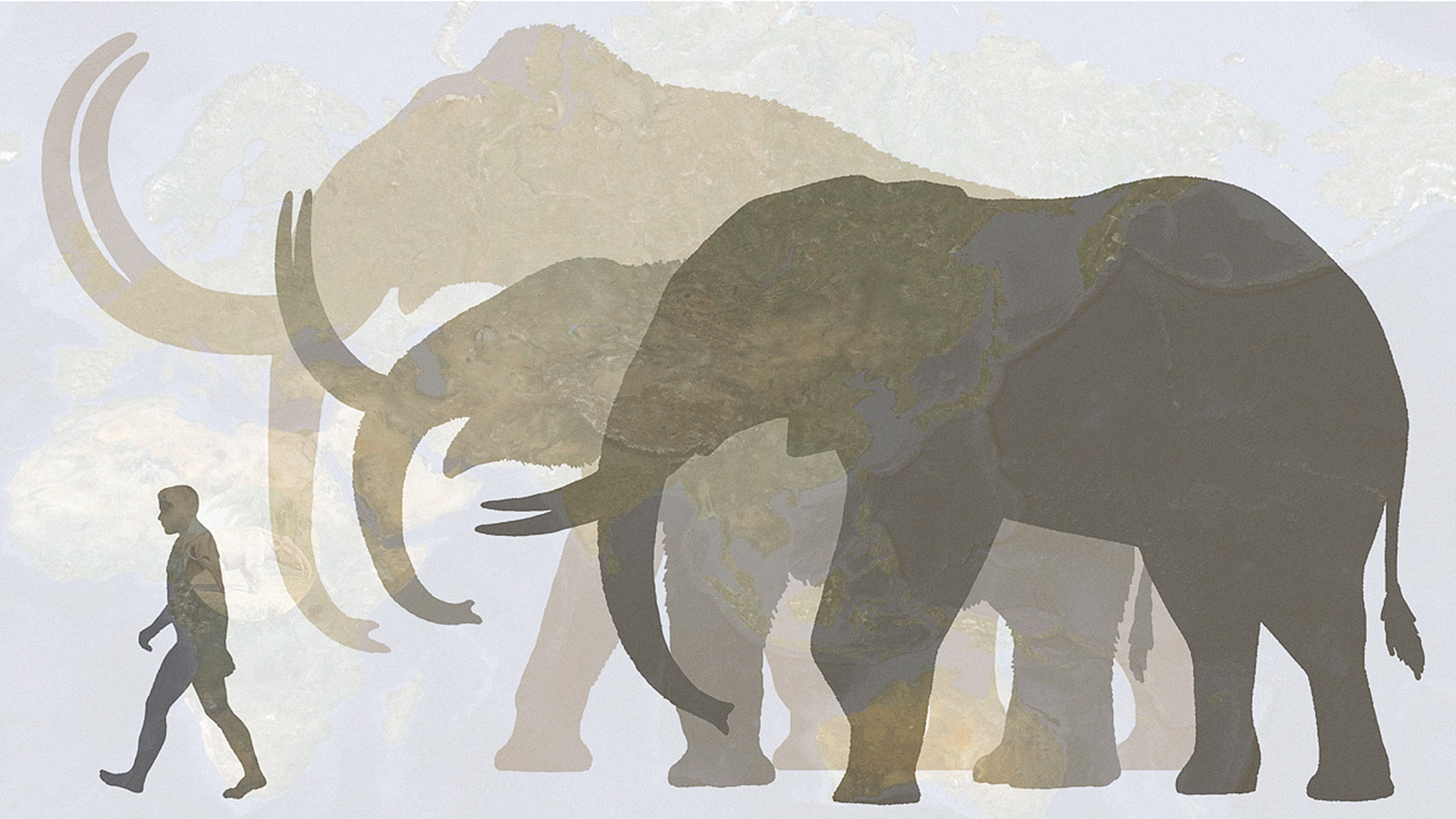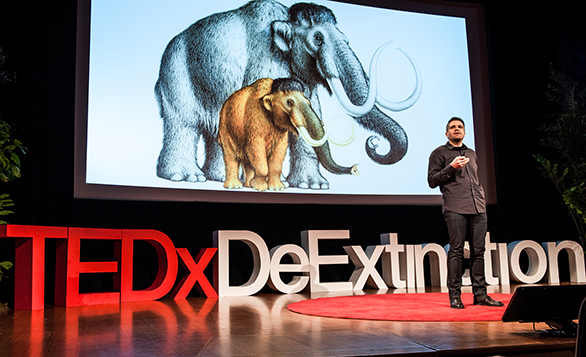 Sequencing an extinct genome is no longer a pipe dream, says evolutionary biologist and ancient DNA specialist Hendrik Poinar in today’s talk. It’s a modern reality, and we’re not too far from seeing a revived extinct species walking the Earth again — maybe even a woolly mammoth. In this talk from TEDxDeExtinction, Poinar talks about how he and fellow scientists are getting closer to completing a woolly mammoth genome, an intricate puzzle that consists of discovering, entangling and connecting over 5 billion base pairs.
Sequencing an extinct genome is no longer a pipe dream, says evolutionary biologist and ancient DNA specialist Hendrik Poinar in today’s talk. It’s a modern reality, and we’re not too far from seeing a revived extinct species walking the Earth again — maybe even a woolly mammoth. In this talk from TEDxDeExtinction, Poinar talks about how he and fellow scientists are getting closer to completing a woolly mammoth genome, an intricate puzzle that consists of discovering, entangling and connecting over 5 billion base pairs.
 Hendrik Poinar: Bring back the woolly mammoth!
So, why do we, humans, have such a fascination with woolly mammoths?
Hendrik Poinar: Bring back the woolly mammoth!
So, why do we, humans, have such a fascination with woolly mammoths?
“Woollys are a quintessential image of the Ice Age … We seem to have a deep connection with them as we do with elephants,” says Poinar in this sci-fi worthy talk. “I have to admit there’s a part of the child in me that wants to see these majestic creatures walk across the permafrost of the North.”
It may be even more of a possibility now, thanks to a new development. Earlier this week, an incredible discovery on the permafrost of the Novosibirsk archipelago in the Arctic Ocean propelled the conversation of de-extincting mammoths forward: Blood, possibly in liquid form, and muscle tissue was discovered inside the well-preserved body of a 10,000 to 15,000 year old female woolly mammoth. (Read scientists’t
Thanks to frozen carcasses with skeletons, stomach contents, tusks and now liquid blood left intact — as well as cave painting depictions by our human ancestors — scientists know more about the woolly mammoth than any other prehistoric animal. Here are ten facts about the magnificent woolly mammoth, Mammuthus primigenius, to help ignite your imagination.
- Contrary to common belief, the woolly mammoth was hardly mammoth in size. They were roughly about the size of modern African elephants. A male woolly mammoth’s shoulder height was 9 to 11 feet tall and weighed around 6 tons. Its cousin the Steppe mammoth (M. trogontherii) was perhaps the largest one in the family — growing up to 13 to 15 feet tall.
. - The ears of a woolly mammoth were shorter than the modern elephant’s ears. Like their thick coat of fur, their shortened ears were an important cold-weather adaptation because it minimized frostbite and heatloss.
. - Scientists can discern a woolly mammoth’s age from the rings of its tusk, like looking at the rings of a tree. The tusk yields more finite detail than a tree trunk, revealing a major line for each year and a line for the weeks and days in between. Scientists can even tell the season when a woolly mammoth died as the darker increments correspond to summers. The thickness or thinness of the rings indicate the health of the mammoth during that time; the tusk would grow more during favorable conditions.
. - The woolly mammoth was not the only “woolly” type of animal. The woolly rhinoceros, also known as the Coelodonta, co-existed with the woolly mammoth, walking the Earth during the Pleistocene epoch. Like the woolly mammoth, the woolly rhino adapted to the cold with a furry coat, was depicted by human ancestors in cave paintings and became extinct around the same time.
. - Cave paintings drawn by ice age humans show the important relationship they had with the woolly mammoths. The Rouffignac cave in France has 158 depictions of mammoths, making up about 70% of the represented animals that date back to the Upper Paleolithic period. There is also evidence of the use of bones and tusks by humans to create portable art objects, shelters, tools, furniture and even burials.
. - Today, the hunt is on for woolly mammoth tusks in the Arctic Siberia. Due to global warming, the melting permafrost has begun revealing these hidden ivory treasures for a group of local tusk-hunters to find and sell. A tusk can range from 10-13 foot in length and a top-grade mammoth tusk is worth around $400 per pound. Mammoth ivory, unlike elephant ivory, is legal.
. - The first fully documented woolly mammoth skeleton was discovered in 1799. It was brought to the Zoological Museum of the Zoological Institute of the Russian Academy of Science in 1806 where Wilhelm Gottlieb Tilesius put the pieces together. Basing his task off of an Indian elephant skeleton, Tilesius was successful in reconstructing the first skeleton of an extinct animal except for one error. He put the tusks in the wrong sockets, so that they curved outward instead of inward.
. - The coat of a woolly mammoth consisted of a “guard” of foot long hairs, and an undercoat of shorter hairs. Preserved mammoth hair looks orange in color, however researchers believe the pigment was changed because of prolonged burial in the ground.
. - Even a kid can discover a preserved mammoth. In September 2012 in Russia, an 11-year-old boy named Yevgeny “Zhenya” Salinder happened upon an extremely well-preserved woolly mammoth carcass while walking his dogs. The remains were of a 16-year-old male woolly mammoth that died about 30,000 years ago. The discovery helped scientists conclude that the large “lumps” on a mammoth’s back were extra stores of fat to help it survive winters. The mammoth was nicknamed “Zhenya.”
. - The final resting place of woolly mammoths was Wrangel Island in the Arctic. Although, most of the woolly mammoth population died out by 10,000 years ago, a small population of 500-1000 woolly mammoths lived on Wrangel Island until 1650 BC. That’s only about 4,000 years ago! For context, Egyptian pharoahs were midway through their empire and it was about 1000 years after the Giza pyramids were built. The reason for the demise of these woolly mammoths are unknown.
Watch all 25 talks from TEDxDeExtinction here »

Hendrick Poinar shares how his team is sequencing the woolly mammoth genome. Photo: courtesy of TEDxDeExtinction
Comments (74)
Pingback: Quora
Pingback: ¿Verdadero o falso? Diez hechos tan curiosos que podrían ser inventados (y tal vez lo sean) | Cooking IdeasCooking Ideas
Pingback: 15 Facts You'll Want To Tell All Your Friends - Do You Still Hate Me?
Pingback: 15 Facts You’ll Want To Tell All Your Friends | SaltyPepper
Pingback: Andrea Gabriel | 10 Fascinating Facts About Woolly Mammoths
Pingback: Woolly mammoths are not as old as you think! - The Illuminati | NWO | New World Order
Pingback: Woolly mammoths are not as old as you think!
Pingback: 25 Random Facts List #14 - KickassFacts.com
Pingback: Science Saturdays: Mammoth Facts | captain overpants
Pingback: [Friday] – 08.11.2013. | Džecin blog
Pingback: Texel fossil woolly rhinoceros discovery | Dear Kitty. Some blog
Pingback: Report Of Liquid Woolly Mammoth Blood Prompts Clone Talk | Nation & World News
Pingback: Charles Saulson,
Pingback: Daryl Bujak
Pingback: Glenn aronow
Pingback: Report Of Liquid Woolly Mammoth Blood Prompts Clone Talk | South Monitor.com
Pingback: Report Of Liquid Woolly Mammoth Blood Prompts Clone Talk | NEWSLETTERS FORUM